Theatres. Theatres. Theatres. Theatres. Theatres. Theatres. Theatres. Theatres. Theatres. Theatres. Theatres. Theatres.
| PAGE MENU |
|---|
| MECHANIC’S INSTITUTE TOWN HALL |
| KINGS HALL |
| LYRIC THEATRE |
| STRATHFIELD DRIVE-IN |
| RESIDENTIAL COLLEGE THEATRE |

Thanks to the people at the Australian Museum of Motion Picture and Television Inc,
Australia’s theatres have been well documented on its website.
The following information has been used from
“Cinema Web : Kalamunda to Kwinana“
and the page is well worth a look as it lists all the theatres in Western Australia.
Read more
THE HISTORY OF THEATRE IN KATANNING
Theatres appear to have played an important part of the Katanning social and entertainment scene since the turn of the last century. Live theatre, musicals, silent and sound movies have all been seen in the various theatres around the town.
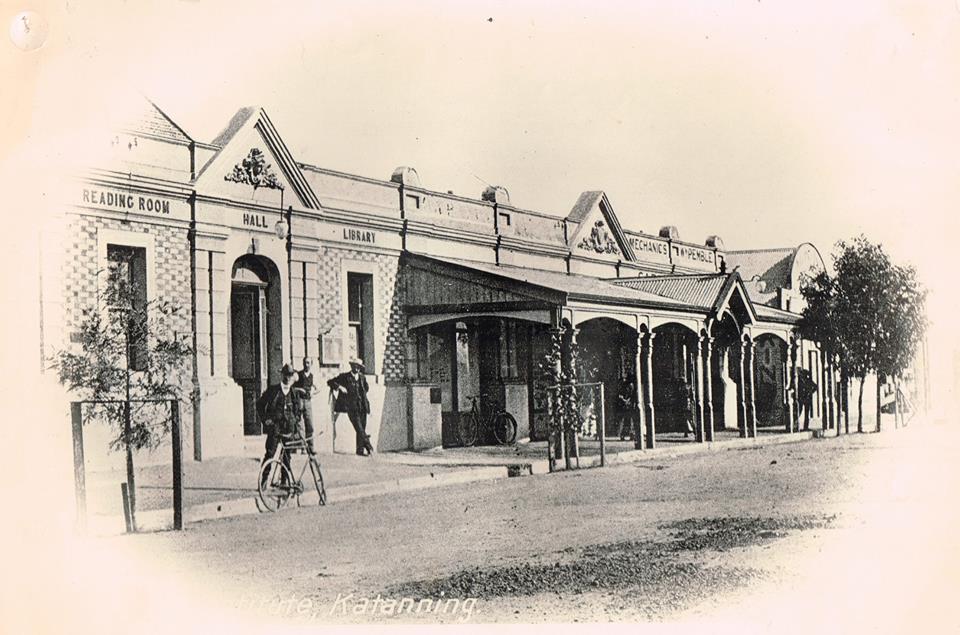
The facade of the Mechanic’s Institute hall c1900
.
.
MECHANIC’S INSTITUTE/TOWN HALL
The foundation stone for the Agricultural Hall was laid on 22 August 1896, and the building was officially opened in 1897. After a public meeting in 1899 the interests of the Agricultural Hall committee and the Mechanics Institute were merged and the hall became known as the Mechanics’ Institute and Public Hall. In 1903, after some controversy, it became simply the Mechanics Institute, and at that time the Roads Board was using part of the building for offices.
This was probably the venue for the early presentations by travelling exhibitors, such as the Salvation Army Biorama Company (in September 1900, November 1900, September 1902 and February 1904), and Stevenson’s Royal Biograph (in January 1905).
In 1907 a new hall was constructed next door, with the Mechanics Institute renovated but no longer used as a hall. Merle Bignell (p.238) describes how the new building included: “four shops, a main entrance, a spacious cloakroom, a ticket office, a large stage and dressing rooms.” Inside, it had painted stage backdrops, a panelled ceiling and electric lighting.
It was opened on 27 May 1907, in time for the Tait’s to show The Kelly Gang in July 1907, Robbery Under Arms in January 1908, and for the Corrick’s to perform there in December 1909. When West’s began their first country circuit in 1909, the Katanning Mechanics Institute appeared on the list every Wednesday. Merle Bignell speaks of ´an ugly tank-like box’ (p.241) which had been installed as early as 1908 to house the projection apparatus.
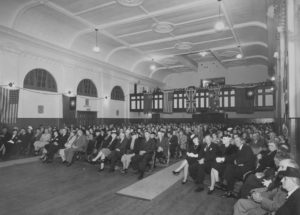
Interior of Katanning Town Hall c1930
From early in 1910, King’s Pictures were screening weekly in the Institute, managed first by H. Brown, then by J. Punch, who in 1912, converted the skating rink into King’s Hall. When that conversion was completed, King’s Pictures moved into King’s Hall and G. Galbraith took over the Thursday screenings in the Mechanics’ Institute, calling them Royal Pictures. By November 1913 the business was called Passmore’s Pictures, managed by S.H. Passmore, and by April 1914 it was Tivoli Pictures, managed by H. Delavale, which seems to have gone into recess for some time in 1914-15, but opened again in October 1915.
It was renamed Katanning Pictures in March 1916, when it was taken over by Messrs Braund and Hales, and Katanning Pictures was run from August 1916 by the Returned Soldiers and Sailors Provident Association.
One story has it that Robert Braund passed over the business during the war as a gesture to the war effort, and was distressed to find that after the war the group managing the films refused to restore the business to him. By now the venue was usually known as the Town Hall with screenings for the benefit of veterans, variously known as Provident Pictures and Repatriation Pictures, and lasting into the twenties.
One informant can remember that about 1920 there were free pictures for children on Saturday afternoons in the Town Hall, but no-one can explain why these were free. Several can remember either Miss Purkiss or Gordon Beck playing the piano for the silent movies. Piesse describes how his sons caught mice in the sheds on the farm and took them to the theatre to release during the pictures.
In November 1927, the front section of the hall was entirely rebuilt, providing a second storey at the front of the building, for new Municipal Offices and a bio-box and upstairs foyer and balcony for the hall. Town Hall Pictures and/or Repatriation Pictures continued and, in April 1931, sound films arrived, first at the Lyric, then at the Town Hall.
Various private managements renamed the Town Hall. From November 1931 it was known as the Golden Gate Theatre, then, when Nelsons took over in December 1933, it was refurbished and re-opened as the New Plaza Theatre: in December 1935 the last night of Town Hall Talkies was advertised and the new Plaza Theatre was to open the following Tuesday, 10 December 1935.
In April 1938, however, ´Town Hall Pictures’ were advertised as returning to the Town Hall where a complete new sound system had been installed: the following week, Katanning Pictures (Town Hall Pictures renamed again?) began advertising again in conjunction with the Lyric gardens. It is now very difficult to sort this out without new information coming to light.
The big hall is beautiful: high moulded plaster ceiling, panelled walls, jarrah floor. It has a large downstairs foyer, with a small room under the stairs now used for cleaning equipment but once the concession. At the top of the impressive staircase is a second foyer, with entrance to the lounge seating: the former entrance to a balcony above the verandah which once ran along the facade has now been filled in and the external balcony removed.
The old supper room was under the stage, with entrance by stairs either side of the stage: these stairs are now covered by the stage extension, and the supper room is used as dressing rooms for stage presentations. The Katanning Town Hall crest is conspicuous above the proscenium arch. The rows of padded seats could be pushed back to the rear of the lower hall when the space was needed for dances.
In the forties, H. F. and Les Kanzler leased the hall for films and this permanent booking on the hall at weekends meant that any local dances had to take place at Broomehill. People who worked for Les Kanzler at this time as projectionists included Ross Page, Doug Brooks and Peter (Pud) Hanna. Kanzler screened two changes weekly: Wednesday night (sometimes a re-run), then Friday/Saturday (and occasionally Monday if the film was a blockbuster).
Ainslie Evans remembers that her father was ‘man-powered’ during the war to do community work, which took the form of acting as fireman at the cinema. The family lived eight miles out of town, so the government paid for the petrol: this delighted the children, as the availability of transport and free tickets meant that the whole family would go. Her father’s axe and torch were kept in a small cupboard near the door, and the first thing he did before each screening was check that all doors could be opened from inside.
Local residents remember the Town Hall pictures with affection. Friday was shopping day, when the families who lived out of town would come in for the day, complete their shopping, then have dinner at the local cafe, with everyone dressed up for the occasion. Sometimes the whole family would then go to the pictures: or Mum and Dad would drop the young people off at the pictures and go home themselves, leaving the young people to find a lift home with a neighbour, or perhaps Mum and Dad would go off to play cards and pick up the young people after the pictures. One young man, while he was still single, would ride his horse in four miles to town, tie it up at the stables (or to the rings on the verandah posts at the Federal Hotel), and walk up to the pictures.
There were usherettes to show you to your seat, though they were not in uniform. There was a certain social distinction between those who sat downstairs and those who paid the higher prices upstairs. Ainslie Evans remembers that while she was growing up, if you paid for yourself you went downstairs, but if you went with a boy he paid for you to go upstairs: that he was willing to do this meant the boy was really serious! If you were on your own and had not paid for a coveted upstairs seat, you could slip quickly upstairs at interval and appear on the balcony – a very innocent deception. Mrs Slater had a shop in the foyer, and this would be rushed at interval: one favourite was Silver Sammy’s (caramel covered with chocolate at one end), or penny chewing gum.
Babies could be left in the cloakroom at the entry – called the ´crying room’, though it was not the kind that allowed a parent to tend to a baby and still watch the film: instead, the fireman would call the mother out if the baby cried. Or you might leave the baby asleep in the car outside, in which case a slide would appear on the screen: ´Baby crying in KA 43′.
There were no toilets in the hall. The men’s toilets were outside and behind the hall and men did not have to pay. The women’s toilets were across the road, and cost 1d: so the first person had to pay, then each person in the queue would keep a foot in the door so they could go in without paying. There were only four pan toilets in this block, and on a good night they would all be overflowing by the end of interval.
People could remember paying 5/- (.50c) upstairs and 2/6 (.25c) downstairs, or (earlier) 2/- (.20c) upstairs and 1/2 (.12c) downstairs. Children sat in the front on wooden seats. Adults sat in padded seats upstairs and wooden one downstairs: all closed automatically when you stood up, so made a great noise! Some people, such as the Hanna family, had permanently booked seats. There was no heating in the hall till recently, so everyone took blankets in cold weather. Screenings continued at the Town Hall until the drive-in was built in 1961, then there was a long gap.
Roy Mudge started screening at the Katanning Town Hall on 23 January 1996 with Free Willy 2: he then screened every third Saturday till 9 July 1996, his last film being Dunstan Checks In. Steve Marvin then took over, and continued to screen irregularly. He would bring his own projector and screened from the bio-box, using the screen on stage. He showed four or five times a year – mainly children’s films (though he did bring Shine).
.
KINGS HALL
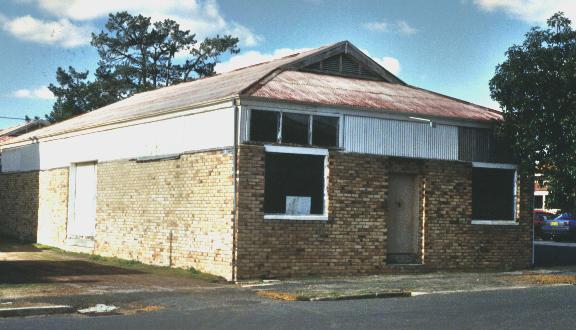
Kings Hall c1990
The hall has since been demolished after being destroyed by arsonists about 2010.
Holly’s shed faced Aberdeen St, but with a postal address in Austral Terrace: it was located behind the Mechanics Institute but slightly closer to Clive St. About 1909, this shed was converted into a roller skating rink, with a jarrah floor.
In August 1912, J.A.Punch, who was managing Kings Pictures, moved from the Mechanics Institute to this roller skating rink, which had been converted for films, and renamed it Kings Hall. For some time Kings Pictures operated there in competition with various managements at the Mechanics Institute, though on at least one occasion (in October 1916) the Mechanics Institute exhibitor screened in the King’s Hall while the Institute was otherwise occupied (by a performance of The Mikado).
Kings Pictures was taken over by Mr Lambert in August 1915, and it is not clear when regular screenings ceased in the hall. (from Cinemaweb)
From early in 1910, Kings Pictures were screening weekly in the Institute, managed first by H. Brown, then by J.Punch, who in 1912 converted the skating rink into King’s Hall. When that conversion was completed, King’s Pictures moved into King’s Hall and G.Galbraith took over the Thursday screenings in the Mechanics Institute, calling them Royal Pictures.
.
LYRIC THEATRE
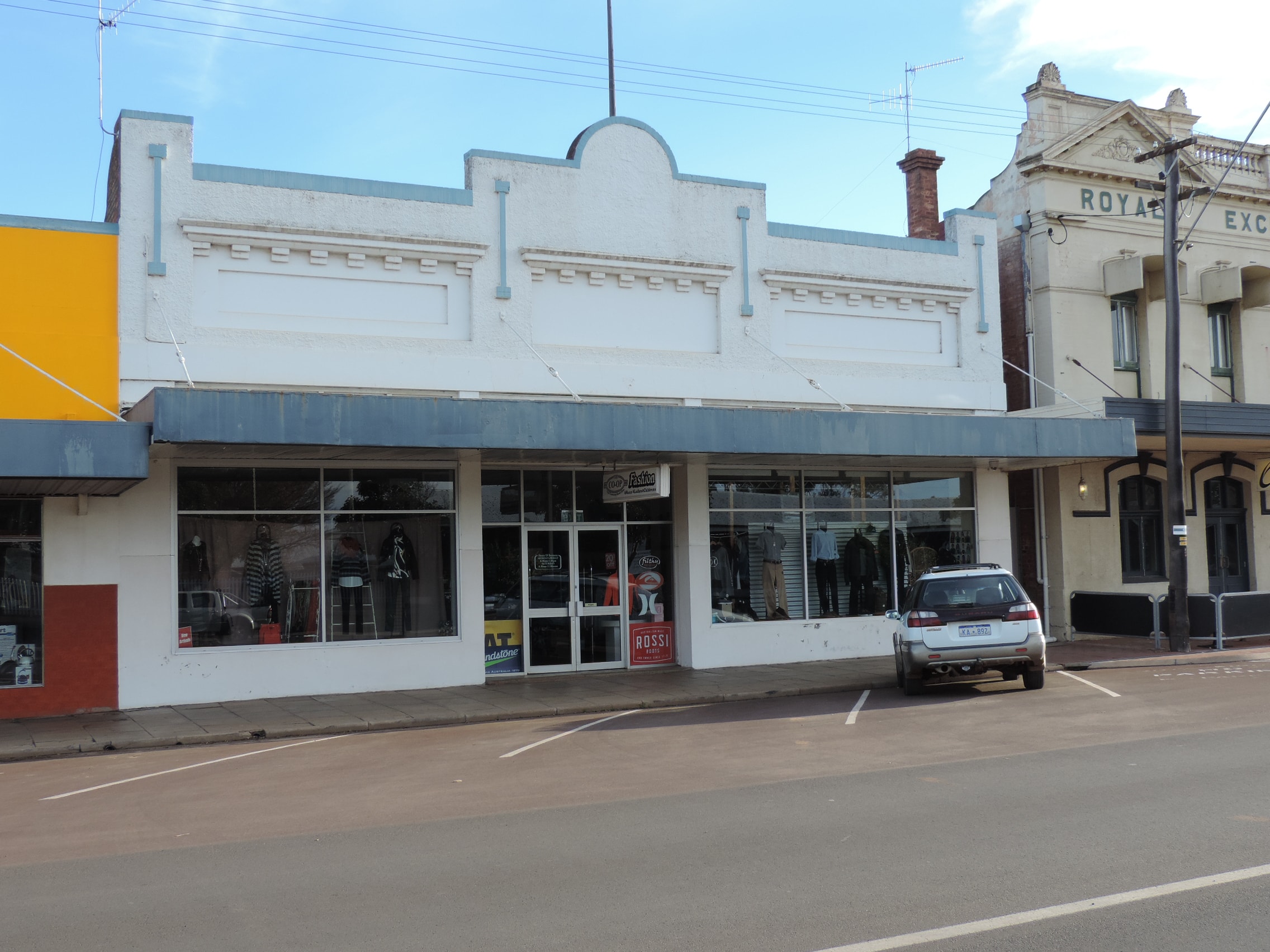
The Lyric Theatre c2015
On 1 October 1925 the Lyric Theatre was opened in Austral Terrace opposite the railway station and between Albion and Broome Streets. At first, this was a gardens run in the summer months, with screenings in the winter being moved to the Town Hall. It was conducted at first by Repatriation Pictures and later in the twenties by George McLeod, who also owned the adjacent hotel.
It had the usual high fence and deckchairs. Katanning weather was less favourable to outdoor entertainments than some of the more northern parts of the state, so after only a short time (perhaps two to three years), the building was roofed.
It was a large auditorium, with a foyer larger than usual in such buildings and a sprung floor which made it suitable for dancing. The deckchairs continued to be used inside the new building. In April 1931 sound films arrived, first at the Lyric, then at the Town Hall.
(Problems after this – there seems to have been some dispute in the thirties about the lease on the Lyric, but it is not clear why. Then there is confusion between the Lyric and the Town Hall over which one was renamed the Plaza and for how long.)
Local residents remember the Lyric operating in the thirties as a large multi-purpose venue, with the Town Hall the main cinema in the town. Saturday afternoon pictures at the Lyric cost children 6d, and their parents might also give them one penny to spend. On Sunday nights entrance to the films cost a silver coin donation, but on other nights the building was used for other purposes: Monday & Friday were auctions, Tuesday dancing, Wednesday skating.
During film screenings, a fireman in uniform was always in attendance, and smoking was not allowed. However, smoking was allowed during other entertainments in the building, which was also used during World War 2 for boxing matches. One referee for these matches, and trainer for the local football club, was Dave Walters – a large and imposing man who also acted as usher in the cinema, ever ready to break up a disturbance or interrupt unseemly conduct by shining his torch on the culprits.
In 1930, Masters Pictures, run by Meggy Masters from Kojonup, ran the Lyric and the Town Hall for a short time, but, despite pleas in the Great Southern Herald for support from the local audience, the business failed, and was taken over by others. (Autumn Club members say this happened after World War 2, after Masters had won Tatts). The chief projectionist before and during World War 2 was Bruce Dunlop, and his assistants were Max Tonkin, Scott Wilson, Herb Wanke, and Ziggy Squires (who was killed in the war).
After its use as a cinema ceased, the building became a second-hand shop, then Wesfarmers, then in 1984 it was purchased by the BKW Co-op. In 2016, the Lyric building was still there, though unrecognisable: the ladies wear section of the BKW Co-op had been built inside the theatre (like a Chinese box), so the ceiling of the old hall could still be seen inside the storage section at the back of the shop, and the roof of the old theatre was clearly visible from the rear of the building.
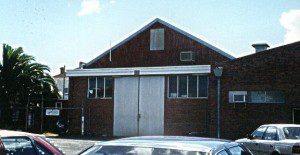
Rear Lyric Theatre 2016
U.A.O.D.
ANNUAL CHRISTMAS TREE
Great Southern Herald
24 December 1927 – p7
The Lyric Theatre was the scene of festivity on Monday evening last, the occasion being the annual Xmas Tree run by members and officers of the Katanning branch of the United Ancient Order of Druids, for the benefit of the younger generation.
Shortly after eight o’clock Father Christmas arrived on the scene and proceeded to distribute presents to the young revellers from a gaily illuminated Xmas tree near the stage of the hall. The children were entertained by dancing, scrambles and the distribution of prize bags, and judging from the merry din which issued from the theatre, the young participants were well entertained. During the evening, Mesdames T. Markey and W. Tuck, for services tendered during the year at all Druid functions, were presented with handsome tokens of appreciation by the officers of the Lodge.
At 11 o’clock adults took possession of the floor and dancing was continued till midnight to strains of music supplied by Markey’s Band. Results of raffles during the evening were as follow: Xmas stocking, Mrs. T. Markey; Xmas Cake, Mrs. Finlay.
1934 MOVIE BALL
Great Southern Herald
11 August 1934 – p4
On Thursday evening the 1934 Movie Ball was held in the Lyric Theatre, Katanning, under the able management of the Plaza Theatre, assisted by Mr. G. W. Beeck and the ladies of the Infant Health Association.
The scheme of decoration was novel and effective, and took the form of gum brandies and wattle blossom, through which coloured lights shed their subdued rays, giving the effect of a moon-lit sylvan glade, while large “cut-outs” of numerous movie stars smothered the walls. A pleasing effect was obtained from a powerful blue light fixed in the ceiling of the hall, combined with a spotlight from the operating box, which, with all remaining lights extinguished, produced enchanting illumination for the novelty dances.
An excellent buffet supper was served by the committee of the Katanning Infant Health Centre, and Mr. Gordon W. Beeck ably carried out the duties of Master of Ceremonies and presented the prizes for the fancy costumes.
Unfortunately, the number in fancy-dress did not come up to the expectations of the organisers, there being only one set, which was taken from the garage scene of “The Millionaire”, carried out by Misses Hurst, Scrymgour, Harris, McGregor and Messrs. C. Dilworth (The Millionaire), G. Hobbs, N. McDonald and King. Messrs. O. Stephens and K. Severin caused much merriment in their antics as “The Hayseeds”, while Misses M. Hobbs and D. Keenan looked soldierly in their costumes of the Foreign Legion.
From a leafy pagoda in the front of the hall. Hicks’ Bon-Ton Orchestra of five instruments dispensed the gayest of music, and dancing was continued until the small hours of the morning. The floor was in good condition for dancing, thanks to the efforts of the organisers, and although the attendance was satisfactory, the ball merited even better patronage, for all arrangements were excellent.
Amongst the dancers in plain dress were noticed:
Misses S. Anderson, blue marocain with cowl effect lined with lemon; M. Bruce, pink marocain featuring long sleeves with high neckline; A. Pickering, floral taffeta in autumn shades; L. Dawson, violet lace with coatee en suite; Saunders, flame marocain; J. Wardle, flame marocain; McAleer, red georgette and black velvet coatee; N. Bartlett, shell-pink georgette; M. Sinclair, green marocain; J. Kelmsley, mauve satin; R. Pennherdt, shell-pink marocain; I. France, green marocain with pink velvet coatee; K. Wilson, black marocain featuring golden shoulder-straps; F. Webb, red satin; O. Bailey, green heavy marocain; E. Stevens, black silver velvet; J. Bentley, red sand crepe; J. Mort, powder-blue marocain; M. Wilhelm, black lace over pink satin; Z. Buchholz, green satin with pink lace yoke effect; M. Clancy, white silk net; G. Fitzgerald, navy blue georgette with red tonings.
M. Williams, white diagonal-striped satin; M. Cronin, mustard satin with train effect; V. Finch, white Swiss voile; M. Baggott, blue satin; M. Cory, blue sand crepe; M. Easther, black velvet with silver lame; E. Hobbs, blue silk velvet; A. Biltoft, pink crinkly crepe; C. Mullineux, blue marocain; C. McDonald, wine velvet; Berlei, white sand crepe; F. Spowart, black marocain with silver lame; M. Cass, black crinkly crepe; J. Abbott, blue marocain; M. King, pink marocain; A. Abbott, green satin; J. Cook, blue matalasse; E. Pickering, blue silk velvet and silver lame; V. Whitton, black lace over white underskirt; P. Barrot, pink marocain; J. Cory, leaf-green georgette; Mesdames G. Beeck, floral georgette; I. Synnott, black lace; D. de Marchi, apricot satin; A. F. Watts, black lace; J. D. Holmes, blue lace; A. Tree, coffee lace with full flare; Mosley, blue organdie; W. McLeod, black marocain with silver lame bodice effect; McKenney, blue marocain; J. Mailer, black marocain; M. Norrish, floral taffeta; R. Norrish, lemon sand crepe.
.
STRATHFIELD DRIVE-IN THEATRE
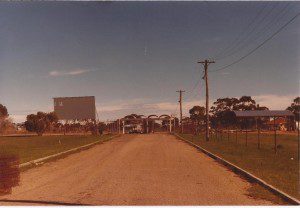
Strathfield Drive-In entrance
This drive-in for 284 cars was built north of the town at the intersection of Oxley and Carew Streets, and opened on 8 February 1961, with a charity gala. Special arrangements had to be made for the installation of a diesel power generating unit, obtained from the State Energy Commission (SEC) pending the arrival of the South West Power Scheme in the area.
The drive-in was owned by Great Southern Drive-in Cinemas Pty Ltd, with Perth engineer (and partner in West Australia’s own sound equipment firm – Greater XL-Tone Amusements) R. Yelland as managing director, L.F(B?) Kanzler (brother of Bert Kanzler who operated the Town Hall/Plaza in Katanning?) as director-in-chief, and Morris A. Blake as director.
It had a children’s playground and a concession building that served meals (their fish and chips was particularly fondly remembered). In the early days, it was so popular that it was necessary to arrive early to be sure of entry. The usual drive-in stories circulate of attempts to avoid paying by covering children with a rug in the back seat or putting adults into the boot of a car.
After television arrived in the district attendance fell off and screenings were provided only three then two nights each week, till it closed altogether in the late seventies? In 1997 the fence was still standing, but apart from that only the concession/bio-box remained, incorporated into the house built on the site.
.
GREAT SOUTHERN RESIDENTIAL COLLEGE
RECREATION CENTRE THEATRE
(Formerly St Andrews Residential College)
The Great Southern Residential College opened as a hostel for High School students on 2nd October 1964. In the seventies, recreation facilities were built, including a large sports stadium, and at the back of this stadium a theatre was added. It had raked seating, holding 120, with a built-in bio-box and a screen with curtains. The project was started by the Hostel manager and Troy Jones, and operated as a cinema for about two years.
In 1997, the theatre re-started film screenings for a short period, both for the residents and as a fund-raising venture for the Hostel.

Visit our FACEBOOK Pages:
KATANNING MEMORIES
LOST KATANNING
.
What is Marocain?
noun. a crepe fabric made of silk, wool, or rayon, or a combination of these fibers, and distinguished by a strong rib effect, used in the manufacture of dresses and women’s suits; a heavy Canton crepe.
What is Matelassé
noun. Also called crepe marocain. Matelassé (French: [matlase]) is a weaving or stitching technique yielding a pattern that appears quilted or padded.
What is Organdie?
noun: organdie; plural noun: organdies; noun: organdy. A fine translucent cotton muslin that is usually stiffened and is used for women’s clothing.”brides in flounced organdie gowns”
PLAZA THEATRE
Great Southern Herald
15 August 1934 – p2
PLAZA THEATRE TO-NIGHT – WEDNESDAY. The programme for to-night (Wednesday) will comprise Kay Francis and Nils Asther in “Storm at Daybreak“, a drama of love and hate, plus the Paramount triumph, “I Love That Man”, featuring Edmund Lowe and Nancy Carroll, a swift-moving dramatic comedy romance.
Theatres
theatres theatres theatres
